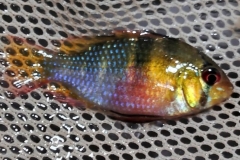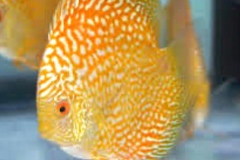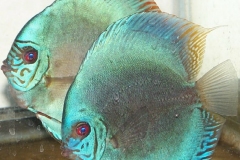We have previously gone over the problem of Angelfish eating their eggs while spawning, or shortly thereafter. We will now go over fertility. Next we will go over what happens once the eggs hatch, but before the fry are free swimming. Fertility is an issue with Angelfish and will vary drastically between different pairs. Some pairs will be totally infertile; other pairs will be infertile at first and then will become fertile. On pairs that are fertile, the percentage of fertile eggs will range from just a few to, best case scenario, about 90% fertility. The amount of fry produced can vary from just a few to a couple of thousand. There are three main causes of infertility in Angelfish. The first one is mechanical and is caused by the male not doing his job and fertilizing the eggs. The second and third are biological and are due to either the eggs or sperm being genetically or chemically infertile. When Angelfish lay eggs, the male should follow the female on a fertilizing run as soon as she does an egg laying run. Some males only make the run after every two or three egg laying runs. It is my experience that these males tend to have a lower fertility rate. Some males will not fertilize at all. These tend to be the males that also are most aggressive on eating the eggs. There is very little you can do to change these males. Some Angelfish are infertile due to water chemistry. To optimize fertility, water temps should be kept constant between 84 and 88 degrees. Ph should be kept constant at 6.5. Heavy filtration, if possible, is a big plus. I try and avoid doing water changes at this time. The hatch rate is the best when the water is soft. Fluctuation in any of the water conditions while the eggs are developing will result in infertility. So once you put them in the hatch tank, DO NOT change any water conditions. Angelfish that are genetically infertile will never be fertile. Please note that keeping water temperatures above 96 degrees for over a week will usually result in the permanent infertility of Angelfish. Some Breeders have been known to purposefully sterilize the Angelfish they sell to keep others from being able to breed the strains they have developed. We would never do this.
Monthly Archives: June 2019
Breeding Angelfish – Part 5 – The Spawning Process
In the last article we went over how to get your Angelfish to spawn. In this article we will go over the actual spawning process. The spawning process is everyone’s favorite part. This is what hooked me on Tropical Fish as a young boy and I still, 45 years after my first spawn, find it fascinating.. The first sign that your Angelfish are getting ready to spawn will be their obsession with cleaning the slate or breeding cone you provided. It will always be on a surface that is mostly vertical and if you do not provide a surface that meets that condition on which you want them to use for spawning, they will spawn on other surfaces that are much more difficult such as the side of the tank or filter tubing. Once you see both of them cleaning the spawning site, spawning will usually follow within a day or two. You will also see them start doing the mating dance. They will swim towards each other at a slightly upward angle. Once they get next to each other, they will shimmer and then swim away from each other at a slightly lowered angle. The mating dance is not always performed. I have found that Wild Caught Angelfish almost always do it, but later generations of tank raised strains often do not. The most spectacular aspect of the spawning will be the colors of your Angelfish. Whatever their color, it will become MUCH more intense and vibrant during spawning. This will be the prettiest you will ever see your Angelfish. They will also become aggressive toward other fish, including other Angelfish, at this time. They will aggressively defend the breeding site from all intruders, including you. If you put your hand in near the spawning site when they are preparing to spawn or have already spawned, they, usually the male, will bite your hand. While it really does not hurt much, they will do it very aggressively, it will startle you and it will be something you want to avoid. At some point after your Angelfish start doing all of the above, they will actually lay the eggs. It will start with the female rubbing her belly, and her breeding tube, against the surface that they have cleaned. She will always lay in an upwards motion. The total length of the spawning run will be between ½ and five inches. She will lay between 1 and 12 eggs per spawning run. They can lay over a thousand eggs at one spawning, but it it usually 3 to 5 hundred. The more mature the pair, the larger the spawn will be. The male Angelfish will usually then follow directly behind her in the same basic motion fertilizing the eggs. The entire process can take between one and five hours. The eggs will usually be beige This is when the fun is over and the frustration can start. The first two issues that you will be confronted with are eating of the eggs, especially by the male, and infertility. In the next article in this series, we will go over Angelfish eating the eggs.







